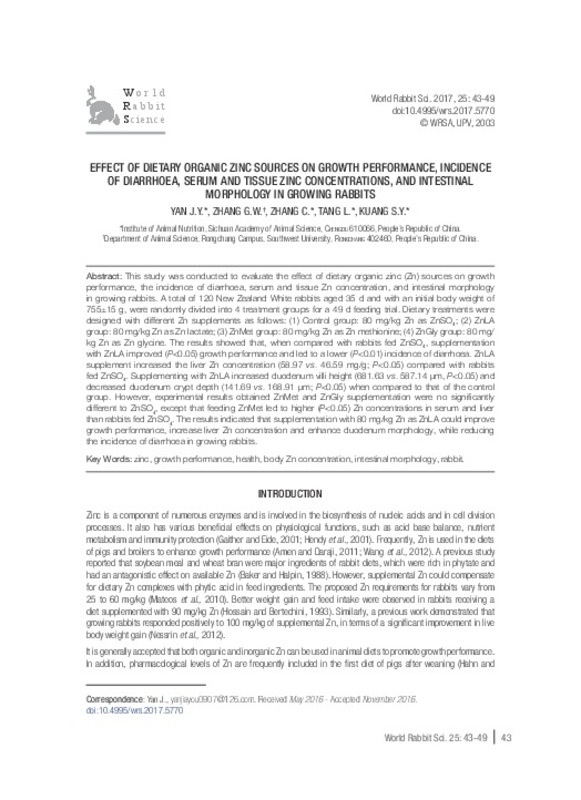JavaScript is disabled for your browser. Some features of this site may not work without it.
Buscar en RiuNet
Listar
Mi cuenta
Estadísticas
Ayuda RiuNet
Admin. UPV
Effect of dietary organic zinc sources on growth performance, incidence of diarrhoea, serum and tissue zinc concentrations, and intestinal morphology in growing rabbits
Mostrar el registro sencillo del ítem
Ficheros en el ítem
| dc.contributor.author | Yan, J.Y.
|
es_ES |
| dc.contributor.author | Zhang, G.W.
|
es_ES |
| dc.contributor.author | Zhang, C.
|
es_ES |
| dc.contributor.author | Tang, L.
|
es_ES |
| dc.contributor.author | Kuang, S.Y.
|
es_ES |
| dc.date.accessioned | 2017-04-03T10:09:44Z | |
| dc.date.available | 2017-04-03T10:09:44Z | |
| dc.date.issued | 2017-03-30 | |
| dc.identifier.issn | 1257-5011 | |
| dc.identifier.uri | http://hdl.handle.net/10251/79356 | |
| dc.description.abstract | [EN] This study was conducted to evaluate the effect of dietary organic zinc (Zn) sources on growth performance, the incidence of diarrhoea, serum and tissue Zn concentration, and intestinal morphology in growing rabbits. A total of 120 New Zealand White rabbits aged 35 d and with an initial body weight of 755±15 g, were randomly divided into 4 treatment groups for a 49 d feeding trial. Dietary treatments were designed with different Zn supplements as follows: (1) Control group: 80 mg/kg Zn as ZnSO<sub>4</sub>; (2) ZnLA group: 80 mg/kg Zn as Zn lactate; (3) ZnMet group: 80 mg/kg Zn as Zn methionine; (4) ZnGly group: 80 mg/kg Zn as Zn glycine. The results showed that, when compared with rabbits fed ZnSO<sub>4</sub>, supplementation with ZnLA improved (P<0.05) growth performance and led to a lower (P<0.01) incidence of diarrhoea. ZnLA supplement increased the liver Zn concentration (58.97 vs. 46.59 mg/g; P<0.05) compared with rabbits fed ZnSO<sub>4</sub>. Supplementing with ZnLA increased duodenum villi height (681.63 vs. 587.14 μm, P<0.05) and decreased duodenum crypt depth (141.69 vs. 168.91 μm; P<0.05) when compared to that of the control group. However, experimental results obtained ZnMet and ZnGly supplementation were no significantly different to ZnSO<sub>4</sub>, except that feeding ZnMet led to higher (P<0.05) Zn concentrations in serum and liver than rabbits fed ZnSO<sub>4</sub>. The results indicated that supplementation with 80 mg/kg Zn as ZnLA could improve growth performance, increase liver Zn concentration and enhance duodenum morphology, while reducing the incidence of diarrhoea in growing rabbits. | es_ES |
| dc.language | Inglés | es_ES |
| dc.publisher | Universitat Politècnica de València | |
| dc.relation.ispartof | World Rabbit Science | |
| dc.rights | Reserva de todos los derechos | es_ES |
| dc.subject | Zinc | es_ES |
| dc.subject | Growth performance | es_ES |
| dc.subject | Health | es_ES |
| dc.subject | Body Zn concentration | es_ES |
| dc.subject | Intestinal morphology | es_ES |
| dc.subject | Rabbit | es_ES |
| dc.title | Effect of dietary organic zinc sources on growth performance, incidence of diarrhoea, serum and tissue zinc concentrations, and intestinal morphology in growing rabbits | es_ES |
| dc.type | Artículo | es_ES |
| dc.date.updated | 2017-04-03T09:52:06Z | |
| dc.identifier.doi | 10.4995/wrs.2017.5770 | |
| dc.rights.accessRights | Abierto | es_ES |
| dc.description.bibliographicCitation | Yan, J.; Zhang, G.; Zhang, C.; Tang, L.; Kuang, S. (2017). Effect of dietary organic zinc sources on growth performance, incidence of diarrhoea, serum and tissue zinc concentrations, and intestinal morphology in growing rabbits. World Rabbit Science. 25(1):43-49. https://doi.org/10.4995/wrs.2017.5770 | es_ES |
| dc.description.accrualMethod | SWORD | es_ES |
| dc.relation.publisherversion | https://doi.org/10.4995/wrs.2017.5770 | es_ES |
| dc.description.upvformatpinicio | 43 | es_ES |
| dc.description.upvformatpfin | 49 | es_ES |
| dc.type.version | info:eu-repo/semantics/publishedVersion | es_ES |
| dc.description.volume | 25 | |
| dc.description.issue | 1 | |
| dc.identifier.eissn | 1989-8886 |








